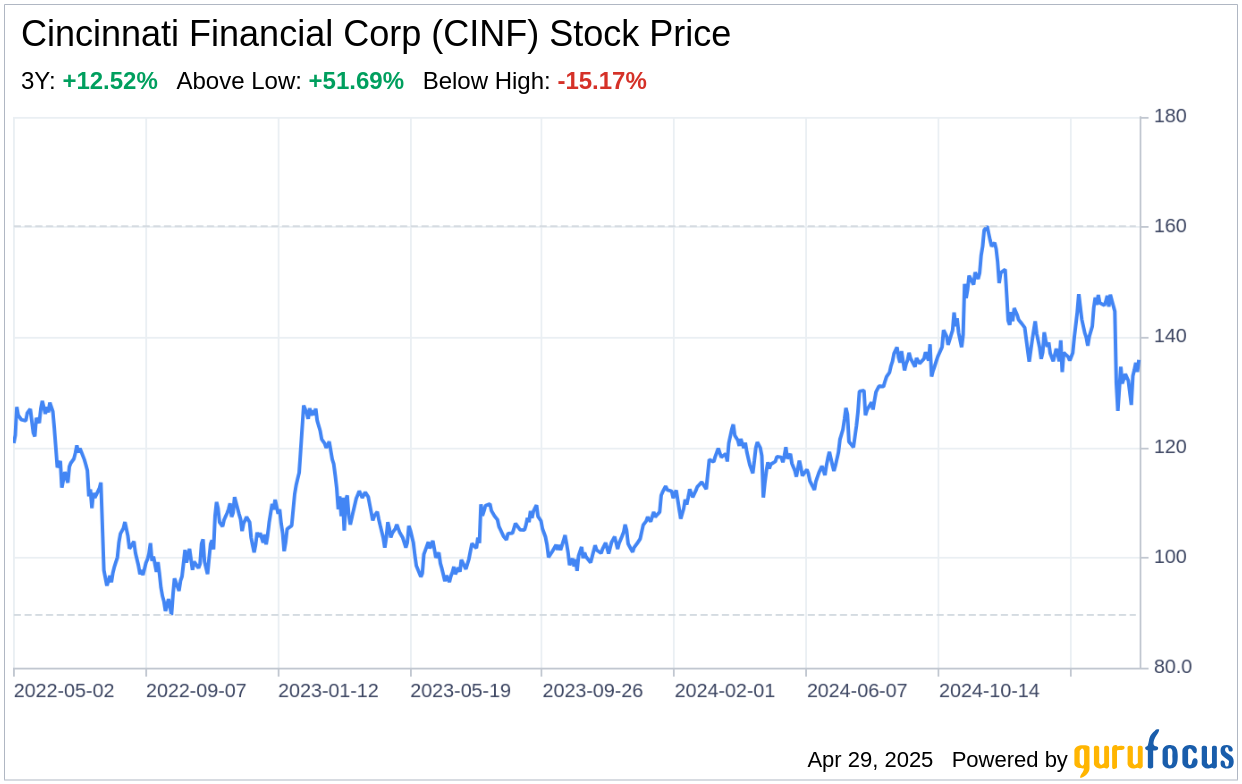Cincinnati Financial Corp (CINF, Financial) presented its first-quarter financials for 2025 on April 28, revealing a challenging start to the year. Despite an increase in earned premiums from $2,071 million to $2,344 million and a rise in net investment income, the company faced a net loss of $90 million, a stark contrast to the previous year's $755 million net income. This downturn was largely due to a significant rise in insurance losses and catastrophe-related expenses, particularly from the January 2025 wildfires in southern California. Shareholders' equity saw a slight decrease, and the company's value creation ratio turned negative, reflecting the impact of these challenges on overall performance.

Strengths
Agency Relationships and Premium Growth: Cincinnati Financial Corp (CINF, Financial) boasts a strong network of independent agencies that has historically driven premium growth rates above industry averages. For the first quarter of 2025, the company reported an 11% year-over-year growth in consolidated property casualty net written premium, surpassing the industry projection of 7%. This growth is a testament to the strength of CINF's agency relationships and its ability to effectively market its insurance products.
Dividend Consistency and Shareholder Value: CINF has a notable track record of rewarding shareholders with consistent dividends, having increased the annual cash dividend rate for 65 consecutive years. The company's commitment to shareholder value is evident in its regular dividend payouts and share repurchase authorizations, signaling confidence in its financial stability and future prospects.
Weaknesses
Underwriting Losses: The first quarter of 2025 was marked by significant underwriting losses for CINF, totaling $298 million. This was a substantial decrease from the $131 million underwriting profit in the same period of the previous year. The losses were primarily driven by catastrophic events, with the January 2025 wildfires contributing to a $450 million increase in losses. This highlights the company's exposure to unpredictable catastrophic risks and the need for improved risk management strategies.
Investment Portfolio Volatility: CINF's investment portfolio experienced a net loss of $67 million, a drastic shift from the $612 million net gain in the prior year. This volatility reflects the susceptibility of the company's investment strategy to market fluctuations and the impact of economic factors such as interest rate changes and global political conditions.
Opportunities
Investment Income Growth: Despite the overall net investment loss, CINF reported a 14% increase in pretax investment income, indicating potential for further growth in this area. The company's strategy to target optimal risk-adjusted, after-tax yields and its diversified investment approach could lead to increased investment income, contributing positively to future profitability.
Technological Advancements: CINF has the opportunity to leverage technology to enhance its underwriting and pricing methods. The adoption of telematics and other usage-based insurance methods, as well as ongoing development and implementation of technology projects, could improve pricing accuracy, underwriting profit, and competitiveness in the insurance market.
Threats
Economic and Regulatory Changes: CINF operates in an environment where economic instability, such as recession or elevated inflation, can lead to decreased demand for insurance products and increased payment delinquencies. Additionally, regulatory changes could impose new obligations, increase expenses, or restrict business operations, potentially impacting the company's profitability and market position.
Competitive Market Pressures: The insurance industry is highly competitive, with constant innovation and changing customer preferences. CINF faces the threat of losing market share if it cannot nimbly develop and introduce coverage product updates and innovations that match or exceed those offered by competitors.
In conclusion, Cincinnati Financial Corp (CINF, Financial) demonstrates a robust foundation built on strong agency relationships and a commitment to shareholder value. However, the company faces significant challenges, including underwriting losses and investment portfolio volatility. Opportunities for growth exist in the form of investment income and technological advancements, but these are tempered by threats from economic and regulatory changes, as well as intense competition. CINF must navigate these dynamics carefully to maintain its market position and drive long-term value creation.
This article, generated by GuruFocus, is designed to provide general insights and is not tailored financial advice. Our commentary is rooted in historical data and analyst projections, utilizing an impartial methodology, and is not intended to serve as specific investment guidance. It does not formulate a recommendation to purchase or divest any stock and does not consider individual investment objectives or financial circumstances. Our objective is to deliver long-term, fundamental data-driven analysis. Be aware that our analysis might not incorporate the most recent, price-sensitive company announcements or qualitative information. GuruFocus holds no position in the stocks mentioned herein.
